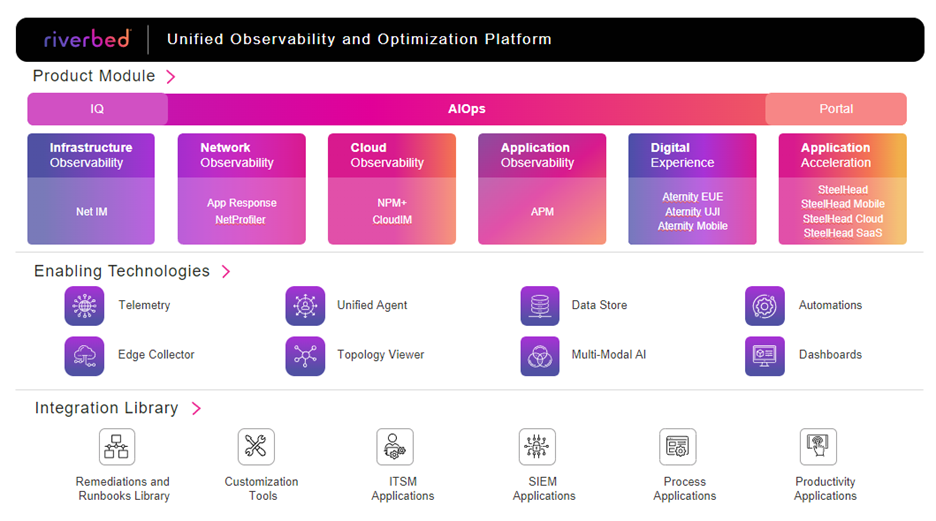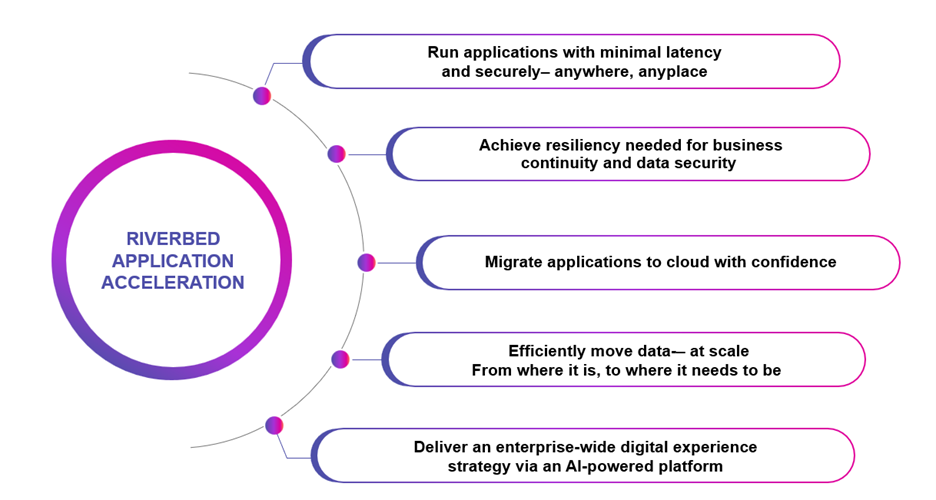 In today’s digital-first world, where data is the lifeblood of every organization, businesses face mounting challenges in managing the increasing demands on their network infrastructure. AI-driven processes have intensified the need to move massive volumes of data quickly and efficiently. With soaring cloud costs and performance bottlenecks that slow critical applications and data transfers, the pressure to optimize network efficiency to ensure business resiliency has never been greater. Cisco, in a noteworthy return to the market after discontinuing its Wide Area Application Services (WAAS), recently announced Data Redundancy Elimination (DRE) as a key addition to its SD-WAN solutions. Riverbed, with a 20-year history of addressing these business resiliency challenges, goes even further, by combining powerful application acceleration and advanced observability solutions.
In today’s digital-first world, where data is the lifeblood of every organization, businesses face mounting challenges in managing the increasing demands on their network infrastructure. AI-driven processes have intensified the need to move massive volumes of data quickly and efficiently. With soaring cloud costs and performance bottlenecks that slow critical applications and data transfers, the pressure to optimize network efficiency to ensure business resiliency has never been greater. Cisco, in a noteworthy return to the market after discontinuing its Wide Area Application Services (WAAS), recently announced Data Redundancy Elimination (DRE) as a key addition to its SD-WAN solutions. Riverbed, with a 20-year history of addressing these business resiliency challenges, goes even further, by combining powerful application acceleration and advanced observability solutions.
Customer challenges
As businesses increasingly adopt AI, remote work, and cloud-based services, the demands placed on network infrastructure are growing exponentially. Rapidly growing data sets challenge networks and applications that must serve the business 24/7, which impacts business resiliency. Sub-optimal network conditions and performance slow down apps and data for employees in the field, threatening employee productivity, customer satisfaction and execution of business-critical initiatives. All of these pose a set of technical and business challenges that organizations must address.
Bandwidth strain and rising costs
The growth in AI workloads, real-time analytics, and data-heavy applications has led to a surge in data traffic across networks. AI processes require rapid transmission of large datasets between on-premises environments, cloud platforms, and edge devices. As a result, organizations are facing increased strain on their network and cloud infrastructures, often pushing them toward costly bandwidth expansions and growing cloud egress consumption.
Latency and performance bottlenecks
AI workloads and data-intensive applications require low-latency environments to function efficiently. In conditions of low bandwidth or poor network performance, latency is a showstopper when transmitting large data sets, slowing down critical processes such as AI model training, real-time data analytics, and cloud-based decision-making. These performance bottlenecks impede business productivity and hinder time-sensitive operations.
Network congestion from increased remote work
The shift to hybrid and remote work has added further complexity to network operations. Employees working from home now regularly interact with AI-enabled tools, cloud applications, video conferencing, and data-heavy resources. However, home networks are typically less robust, leading to issues like network congestion, suboptimal Wi-Fi performance, and poor application responsiveness. Remote workers often experience bandwidth competition from household devices, further straining the network. This creates a challenge for IT teams to ensure consistent performance without control over the user’s network environment.
Data redundancy and inefficient use of bandwidth
AI applications and other data-driven processes often involve repetitive or redundant data transmissions, such as model updates, backups, or replicating similar datasets across different environments. Without the ability to eliminate these redundancies, bandwidth is consumed inefficiently, leading to higher costs and slower network performance.
Increased complexity in network management
Managing network infrastructure has become far more complex as the number of connected devices grows, particularly with AI-enabled endpoints and IoT devices. IT teams must monitor and optimize performance across a more complex ecosystem to ensure excellent digital experience for users of business-critical applications. The lack of visibility into network performance, device configuration, and potential bottlenecks makes it difficult for teams to preemptively address issues.
Riverbed’s experience in ensuring business resiliency
With over twenty years of continuous presence in the market, and as a 9-time Gartner® Magic Quadrant™ Leader in Application Acceleration, Riverbed works with the world’s largest organizations to accelerate applications and move data efficiently and at scale, regardless of location, network conditions, deployment models, or applications used. Riverbed counts 83% of the Fortune Global 500 among its customers. Here are some examples:
- Global Semiconductor and Systems Designer: A leading provider of electronic design automation and semiconductor IP uses Riverbed to ensure resiliency and performance of its CAD and other applications across dozens of locations on three continents.
- Federal Government: A federal government agency relies on Riverbed to accelerate the performance of business-critical applications used by 85,000 employees working remotely and in the office.
- Multinational Commodities: One of the world’s largest commodity trading platforms, with operations on three continents, uses Riverbed to optimize their Microsoft Windows file shares, secure web traffic for their global user base, and accelerate NetApp SnapMirror for their server workloads.
Cisco’s return validates the market need
Cisco recently unveiled its Data Redundancy Elimination (DRE) feature as a key addition to its SD-WAN solutions to address the challenges of data-driven industries. DRE works by identifying and removing redundant data patterns across applications as they are transmitted across sites. By replacing repeated data streams with much shorter reference “signatures,” Cisco claims a traffic reduction of 60-90%.
Cisco positions DRE as a powerful tool for organizations looking to improve bandwidth utilization without needing costly bandwidth upgrades. Cisco’s DRE aims to help businesses manage increasing data volumes without overburdening their WAN infrastructure, enabling them to efficiently manage high demand digital operations.
Cisco’s return to the market is noteworthy after having discontinued its Wide Area Application Services (WAAS), its traditional WAN optimization solution, in 2019. The move came as the market increasingly embraced cloud-native technologies and SD-WAN solutions, which provide more flexible, scalable, and cost-effective alternatives. Cisco cited evolving customer demands and the changing technology landscape as key reasons for the phase-out, encouraging users to transition to its newer SD-WAN offerings.
The advantages of the Riverbed Platform
While Cisco’s new capabilities augment a vast product portfolio spread over many loosely connected technology domains, Riverbed has taken a more direct and comprehensive approach to address these business resiliency challenges. The Riverbed Platform combines powerful application acceleration and unified observability solutions to enable IT to prevent, identify, and resolve issues and to ensure applications run at peak performance – anywhere, over any network, and on any device. It’s a simple, smart, and open platform built on over 20 years of AI and ML expertise.

Riverbed Acceleration enhances network and application performance by optimizing data transfers and eliminating inefficiencies. Riverbed reduces redundant data transmissions, accelerates application delivery, and improves data throughput and resiliency, ensuring that AI workloads, cloud applications, and remote work environments can operate efficiently without overwhelming the network, even under unstable network conditions.
Riverbed Unified Observability provides deep visibility into network performance, application behavior, and data flows across complex, hybrid environments. By collecting real data from the entire IT landscape, analyzing and correlating this data, and leveraging AI for automated remediations, Riverbed delivers actionable insights on what’s happening in the IT ecosystem. This enables IT teams to quickly identify and resolve issues related to bandwidth usage, latency, and data bottlenecks, ensuring smooth operation of data-intensive AI processes and cloud applications.
A closer look at Riverbed Acceleration
Riverbed Acceleration is a purpose-built solution with a depth of technical coverage and superior performance across a wide range of applications and a proven record of scaled deployments within global enterprises and government organizations.

Improve performance of any application, for any user, over any network
Riverbed Acceleration offers comprehensive solutions to boost performance with a focus on security, efficiency, and resiliency. Riverbed ensures consistent application performance whether on-premises, in the cloud, or at the edge. By optimizing data transmission and reducing latency, Riverbed’s solutions help businesses overcome network challenges, providing a seamless user experience and improved productivity.
Attain resiliency for business continuity and data security
Riverbed solutions enable customers to reliably protect more data and recover faster in the face of unforeseen circumstances, outages, and disaster. Riverbed Acceleration solutions quickly, securely, and efficiently move data at scale across the edge, data centers, and cloud to help organizations achieve efficient RTO and RPO.
Migrate applications and data to cloud, confidently
Riverbed helps organizations overcome the risks of diminished performance as they migrate to cloud with Cloud and SaaS acceleration solutions. Riverbed also helps customers protect their investments with Riverbed Flex, which provides assurance that its technology will continue to deliver value as organizations evolve cloud and network architectures and change deployment models.
Efficiently move data at scale over distance
The current methods to transport data from one location to another are slow and unreliable, especially at scale and over long distances. Riverbed accelerates and simplifies the process of moving data across the enterprise IT landscape, helping organizations speed their time to insights, which drives better decision-making.
A multi-vendor approach to improving SD-WAN
While SD-WAN solutions offer measures to guarantee some level of application performance by increasing network efficiency, these features alone are often insufficient to guarantee an excellent end-user experience for business-critical applications. SD-WAN primarily optimizes network traffic routing and enhances connectivity, but it does not address issues like application performance degradation caused by factors such as latency, jitter, or packet loss across global networks.
While Cisco’s introduction of DRE addresses some of these challenges, it does so only for Cisco solutions. While this is sufficient for organizations which rely solely on Cisco, many organizations operate multi-vendor SD-WAN solutions. Riverbed Acceleration works with other vendors of SD-WAN (including Cisco), enabling customers to avoid vendor lock-in as their network and needs evolve over time.
The powerful combination of Acceleration and Unified Observability
Unlike other vendors with partial acceleration or stand stand-alone observability solutions, Riverbed unifies both. After all, observing digital experience is one thing, but actually improving it is the main goal. The Riverbed Platform provides comprehensive, standards-based cloud-native capabilities for deploying and administering Riverbed Observability services. Deployed on Azure, the Riverbed supports a suite of SaaS-based observability tools that IT can deploy quickly, administer securely, and scale seamlessly. With advanced AI and ML-powered analysis and automation engine, the Riverbed Platform enables new services that streamline repetitive tasks so IT can deliver better digital experience.
Get started today!
Riverbed’s cutting-edge solutions tackle today’s toughest network challenges head-on with a powerful combination of acceleration and observability. Riverbed Acceleration enables businesses to run by supercharging data transfers, eliminating redundancies, and speeding up application delivery, so networks are resilient, faster, more efficient, and ready to handle the soaring demands of modern business. But it doesn’t stop there—with real-time visibility into every corner of the network, Riverbed Observability empowers IT teams to detect and resolve bandwidth issues, latency, and data bottlenecks, ensuring flawless performance for AI-driven workloads, cloud applications, and remote workers.
